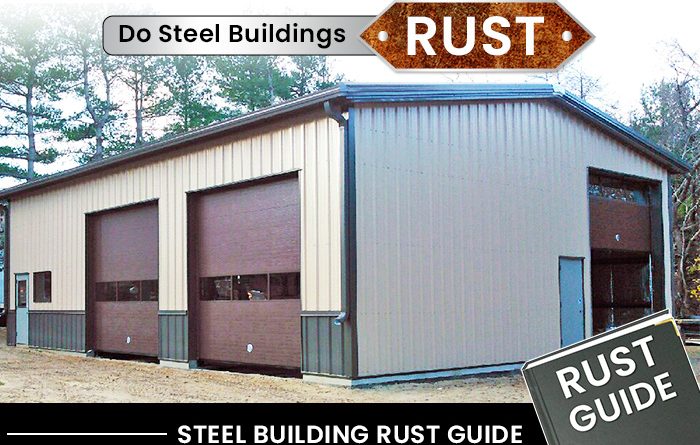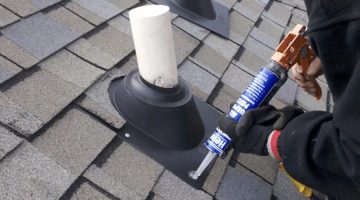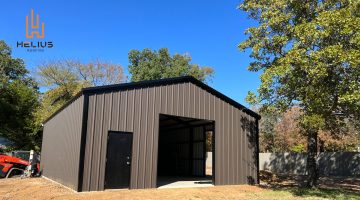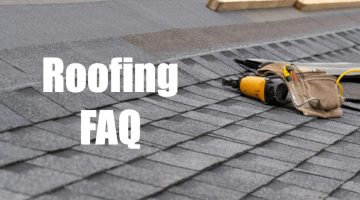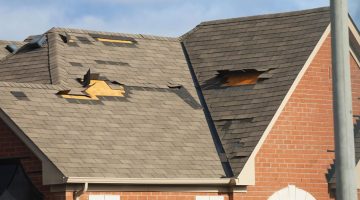By Helius Roofing & Construction

Metal buildings and carports are durable, versatile, and cost-effective solutions for a wide range of needs. Whether you’re using your metal structure to store vehicles, equipment, or for commercial purposes, one of the biggest threats to its longevity is rust. Rust can compromise the structural integrity of metal, lead to expensive repairs, and even cause the entire building to deteriorate prematurely.
At Helius Roofing & Construction, we understand the importance of protecting your investment. In this article, we’ll provide a comprehensive guide on how to prevent and protect your carport and metal buildings from rust, ensuring they remain strong and reliable for many years to come.
What Is Rust, and Why Does It Form?
Rust is a type of corrosion that occurs when metal is exposed to moisture and oxygen over time. This reaction produces iron oxide, commonly known as rust, which weakens the metal and causes it to flake, pit, and degrade.
The process of rust formation is accelerated by environmental factors such as humidity, rain, snow, and exposure to chemicals like salt (commonly used on roads during winter). Because metal carports and buildings are often exposed to these elements, rust protection is crucial to maintain the building’s strength and appearance.
Why Rust Protection Matters
Rust not only affects the appearance of your metal building but also its structural integrity. Over time, rust can eat away at metal components, weakening the frame, panels, and connections. This can lead to costly repairs, safety hazards, and a shorter lifespan for your metal structure. By taking preventive measures against rust, you can extend the life of your carport or metal building and avoid expensive damage down the road.
Ways to Protect Your Carport & Metal Buildings from Rust
1. Choose Rust-Resistant Materials
The first step in preventing rust is to choose rust-resistant materials during construction. Modern metal buildings and carports are often made from galvanized steel or aluminum, both of which offer built-in protection against corrosion.
Galvanized Steel
Galvanized steel is coated with a layer of zinc that protects the underlying metal from rust. The zinc coating acts as a barrier, preventing moisture and oxygen from coming into contact with the steel. This makes galvanized steel an excellent choice for outdoor structures exposed to the elements.
Aluminum
Aluminum is another rust-resistant material because it forms a natural oxide layer when exposed to air. This layer prevents further oxidation, making aluminum carports and metal buildings more resistant to rust than traditional steel. Aluminum is also lightweight, making it an attractive option for those who prioritize easy installation and maintenance.
2. Apply Protective Coatings
For additional protection against rust, applying protective coatings to your metal building or carport is an essential step. Coatings act as a barrier between the metal and the elements, reducing the risk of corrosion over time.
Paint
Painting your metal structure not only enhances its appearance but also provides a protective layer that helps prevent rust. High-quality, weather-resistant paints designed specifically for metal are the best choice. These paints typically contain rust inhibitors that block moisture and air from reaching the metal surface. Acrylic latex paints and epoxy-based coatings are particularly effective for outdoor use.
When painting your metal building or carport, ensure the surface is clean and free of dirt, debris, and any existing rust. A well-prepared surface allows the paint to adhere better and last longer.
Powder Coating
Powder coating is another highly effective way to protect metal from rust. This process involves applying a dry powder to the metal surface, which is then heated to create a durable, protective layer. Powder-coated metal is highly resistant to rust, scratches, and other forms of wear and tear. Powder coating is often used on metal roofs, walls, and framing components for long-lasting protection.
Rust-Proof Primer
Applying a rust-proof primer before painting can further enhance rust protection. Primers containing zinc phosphate or other rust-inhibiting compounds are particularly effective at preventing corrosion. A primer creates a strong bond between the metal and the topcoat of paint, ensuring that the protective layer lasts as long as possible.
3. Perform Regular Maintenance
Regular maintenance is crucial to keeping your metal building or carport rust-free. Inspections should be conducted at least once or twice a year, and any signs of rust should be addressed immediately to prevent further damage.
Visual Inspection
During your inspections, look for any signs of rust, peeling paint, or damage to protective coatings. Pay close attention to areas where water might pool or where metal components come into contact with each other, such as seams, joints, and fasteners.
Remove Dirt and Debris
Dirt, leaves, and other debris can trap moisture against the surface of your metal building, leading to rust formation. Regularly cleaning your structure, especially the roof and gutters, will help reduce the risk of rust. Use a soft-bristle brush or a pressure washer (on a low setting) to remove dirt, dust, and grime from the metal surfaces.
Address Rust Immediately
If you notice any signs of rust, it’s essential to address them promptly. Small rust spots can be sanded down using a wire brush or sandpaper. After removing the rust, apply a rust converter to neutralize any remaining corrosion, then repaint the area with a rust-inhibiting paint or coating.
4. Ensure Proper Drainage
One of the most common causes of rust in metal buildings and carports is water pooling or poor drainage. Standing water accelerates rust formation, so it’s important to take steps to prevent water from collecting around your structure.
Gutters and Downspouts
Ensure that your metal building or carport is equipped with properly functioning gutters and downspouts. These systems direct water away from the structure, preventing it from accumulating on the roof or at the base of the building. Clean gutters regularly to prevent clogs, which can cause water to overflow and damage the metal panels.
Slope the Ground
The ground surrounding your metal building or carport should be graded to slope away from the structure. This will prevent water from pooling near the foundation, where it can eventually seep into seams or joints and cause rust.
5. Use Quality Fasteners and Joints
Rust often starts at seams, joints, and fasteners where water can accumulate. To protect these vulnerable areas, use high-quality, rust-resistant fasteners and components.
Stainless Steel or Galvanized Fasteners
When constructing or repairing your metal building, choose stainless steel or galvanized fasteners, bolts, and screws. These materials are less prone to rust and provide better long-term protection than standard fasteners.
Seal Seams and Joints
Apply a waterproof sealant or silicone caulk to seams and joints to create a moisture barrier. This will help prevent water from seeping into small gaps where rust can begin to form.
6. Control the Environment Inside the Building
If your metal building is enclosed, controlling the internal environment can help prevent rust from forming. Excess humidity and condensation inside the building can lead to corrosion over time.
Ventilation
Ensure that your metal building has adequate ventilation to reduce humidity levels and prevent condensation from forming on the walls and ceiling. Installing roof vents or exhaust fans can improve airflow and keep moisture levels in check.
Dehumidifiers
In particularly humid climates, using dehumidifiers inside the building can help maintain a dry environment and prevent rust. This is especially important if you store moisture-sensitive items or equipment inside your metal structure.
7. Consider a Rust-Resistant Metal Roof
If you’re constructing a new metal building or replacing the roof of an existing one, consider investing in a rust-resistant metal roof. Galvalume and other metal roofing materials are designed to resist rust and corrosion, providing long-term protection against the elements. Rust-resistant roofing can significantly extend the lifespan of your building and reduce the need for frequent repairs.
Conclusion
Rust is a serious concern for any metal structure, but with the right materials, protective coatings, and maintenance practices, you can significantly reduce the risk of corrosion. By investing in rust-resistant materials, applying protective coatings, and performing regular maintenance, you can protect your carport or metal building from rust and ensure it remains durable and functional for years to come.
At Helius Roofing & Construction, we specialize in building and maintaining metal structures that stand the test of time. Contact us today to learn more about how we can help you protect your metal building from rust and ensure it remains in peak condition, no matter the weather.

